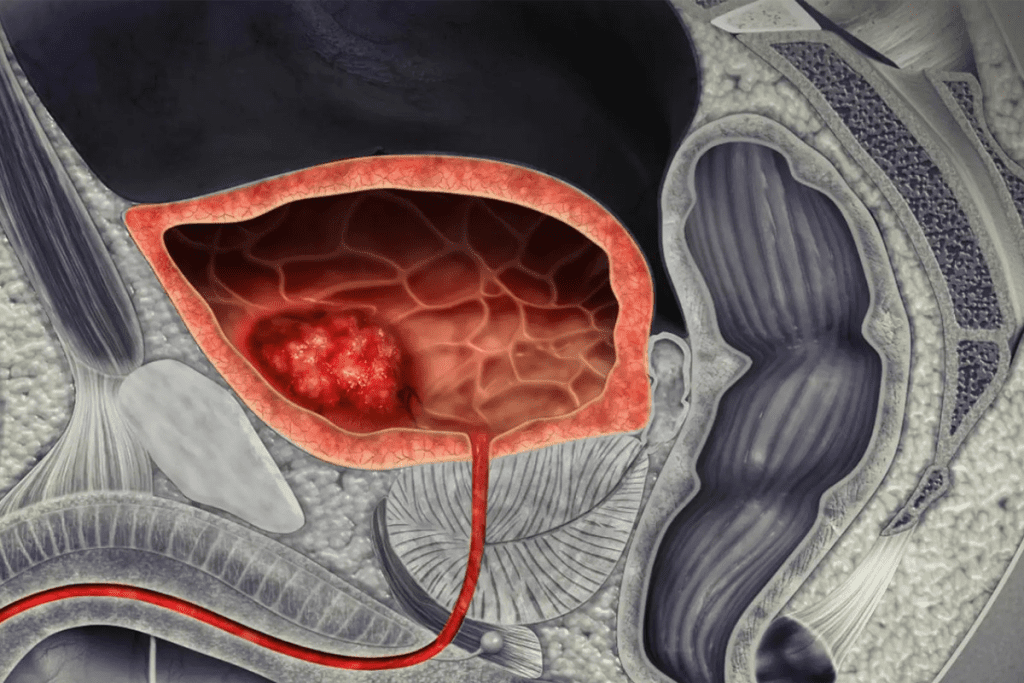Last Updated on November 25, 2025 by

Knowing your chance of getting bladder cancer depends on several things. These include your age, sex, and risk factors. The American Cancer Society says about 84,870 new cases of bladder cancer are expected in the U.S. in 2025. Also, bladder cancer is more common in men than in women. What are the odds I have bladder cancer? Get the bladder cancer survival rate and positive, powerful facts about prognosis and early stage diagnosis.
At livhospital.com, we aim to offer top-notch medical care. We know that bladder cancer risk factors are key in figuring out your chance of getting the disease. For more info on survival rates for bladder cancer, check out trusted sources.
To understand bladder cancer risk, we need to look at the numbers. Bladder cancer is a big health issue in the US. It has many statistics that show how common and impactful it is.
Bladder cancer is the sixth most common cancer in the US. This shows it affects many people. The American Cancer Society says there will be about 84,870 new cases in 2025. This highlights the need for awareness and understanding.

About 2.1% of people will get bladder cancer at some point. This means out of 100 people, about 2 will get bladder cancer. Knowing this can help people make better health choices.
In 2025, there will be around 84,870 new bladder cancer cases. About 17,420 people will die from it. These numbers show why early detection and treatment are key. Bladder cancer survival rates go up when caught early. This makes screening and awareness very important.
By knowing these numbers, people can better understand their risk. They can take steps to protect their health. We’ll look at what affects bladder cancer risk next.
Age and gender are key in figuring out your risk for bladder cancer. We’ll look at how these factors impact your chance of getting this disease.
Men are about four times more likely to get bladder cancer than women. This difference comes from various factors. These include different exposures to risks and body differences.
The median age for bladder cancer diagnosis is 73. This shows that older adults face a higher risk. As we get older, our risk of genetic changes and exposure to harmful substances grows. This is why older people are more likely to get it.
Risk for bladder cancer changes in different groups. For example, some ethnic groups might be more at risk due to genetics. Knowing these differences is key to accurate risk checks.

Age and gender are very important in bladder cancer risk. By understanding these, people can better see their own risk. They can then take steps to prevent it.
Smoking is the biggest risk for bladder cancer, causing about half of all cases. The harmful chemicals in tobacco smoke damage the bladder’s lining. This can lead to cancerous cells forming.
Tobacco smoke has many harmful substances that get into the bloodstream. These substances reach the bladder and damage its lining. This increases the risk of cancer. Studies show smokers are much more likely to get bladder cancer than non-smokers.
Quitting smoking lowers the risk of bladder cancer over time. The risk doesn’t go back to zero right away. But it gets better as the body heals from smoking’s damage. We urge smokers to quit to lower their risk of bladder cancer and other health problems.
Smoking is a big risk for bladder cancer, but other factors matter too. Knowing these risks helps you understand your chance of getting the disease.
Working with certain chemicals, like in dye or paint factories, raises bladder cancer risk. Workers in these jobs need to be careful to avoid harmful exposure.
Having a family history of bladder cancer ups your risk. Genetic predisposition is a factor, so those with a family history should watch closely.
Long-term bladder infections and inflammation can also raise your risk. A medical expert says,
“Chronic irritation of the bladder can lead to cancerous changes over time.”
Learning about the bladder cancer survival rate is key. It shows how well treatments work and why catching cancer early is so important. This info helps both patients and doctors make better choices.
Early detection of bladder cancer leads to a 79% five-year survival rate. This shows how vital it is to catch cancer early. Early detection greatly boosts treatment success chances.
Survival rates change a lot based on the cancer’s stage. For cancer that’s just in the bladder, the five-year survival rate is 71%. But if the cancer has spread, the rate goes down. Knowing these numbers helps understand the disease’s severity.
The treatments chosen are very important for bladder cancer patients. Depending on the cancer’s stage, treatments range from surgery to chemotherapy. How well these treatments work affects the survival rate.
Key Factors Influencing Survival Rate:
By knowing these factors and bladder cancer survival rates, patients can make smarter choices about their diagnosis and treatment.
Spotting bladder cancer early is key. Knowing the signs and acting fast is vital. We’ll cover the common symptoms of bladder cancer. It’s important to watch your health closely.
Blood in the urine, or hematuria, is a top sign of bladder cancer. This symptom should never be ignored. It can mean many things, including cancer. If your urine looks pink, red, or cola-colored, see a doctor right away.
Other signs of bladder cancer include:
These symptoms can really affect your daily life. Talk to a doctor to find out why you’re experiencing them.
If you notice any of these symptoms, make an appointment with your doctor. The earlier bladder cancer is detected, the better the chances for effective treatment and survival.
Don’t wait. See a healthcare provider to check your symptoms and figure out what to do next.
Spotting bladder cancer signs early is the first step to treatment. By knowing the symptoms and getting medical help when needed, you can protect your health.
When you’re diagnosed with bladder cancer, it’s important to know what comes next. We’ll walk you through the steps to diagnose and treat bladder cancer.
The journey starts with a cystoscopy. This lets doctors see inside your bladder. They might also do imaging studies and biopsies to confirm the cancer and its stage.
Treatment plans change based on the cancer’s stage and grade. You might have surgery, chemotherapy, or radiation. Early cancers might need less invasive treatments, while more advanced ones might require stronger treatments.
New treatments for bladder cancer are making a big difference. Immunotherapy and targeted therapy are some of the latest options. We keep up with these advances to give you the best care.
Knowing your risk for bladder cancer is key to staying healthy. We’ve talked about risks like age, gender, smoking, and chemical exposure. Now, it’s time to see how these risks affect you.
The urinary bladder cancer survival rate is a big worry for those diagnosed. The good news is that the five-year survival rate is about 79% for early detection. But, it’s important to know how the bladder cancer recovery rate changes with the cancer’s stage.
Not all bladder tumors are cancerous. Knowing what percentage of bladder tumors are cancerous can ease your mind. Being informed about your risks and the latest stats helps you make smart health choices. If bladder cancer worries you, talk to a doctor about your risk and what to do next.
Being over 73 can raise your risk of bladder cancer. But your risk also depends on other factors. These include your smoking history and chemical exposure.
Smoking is a big reason for bladder cancer, causing about half of all cases. Quitting can lower your risk over time.
Yes, men are about four times more likely to get bladder cancer than women. This is due to different risk factors.
The five-year survival rate for bladder cancer is about 79% if caught early. But survival rates drop as the cancer gets worse.
Look out for blood in your urine, changes in how you urinate, and discomfort while urinating. Seeing a doctor is key if you notice these symptoms.
Tests like imaging and biopsy help diagnose bladder cancer. Treatment depends on the cancer’s stage. It might include surgery, chemotherapy, or immunotherapy.
Cure chances depend on the cancer’s stage and treatment success. Early detection is key to better treatment outcomes.
Not all bladder tumors are cancerous. Some are benign. It’s important to have any tumor checked by a doctor to know its type.
While men face higher risks, women who smoke or are exposed to harmful chemicals also face increased risks. Both men and women should watch out for family history and chronic bladder issues.
To lower your risk, avoid smoking and harmful chemicals. Manage chronic bladder issues. Regular health check-ups can also help catch cancer early.
American Cancer Society. (2025). Key statistics for bladder cancer. https://www.cancer.org/cancer/types/bladder-cancer/about/key-statistics.html
Mungan, N. A., & colleagues. (2000). Gender differences in stage-adjusted bladder cancer survival. Cancer, 89(4), 981-986. https://pubmed.ncbi.nlm.nih.gov/10840099/
Subscribe to our e-newsletter to stay informed about the latest innovations in the world of health and exclusive offers!